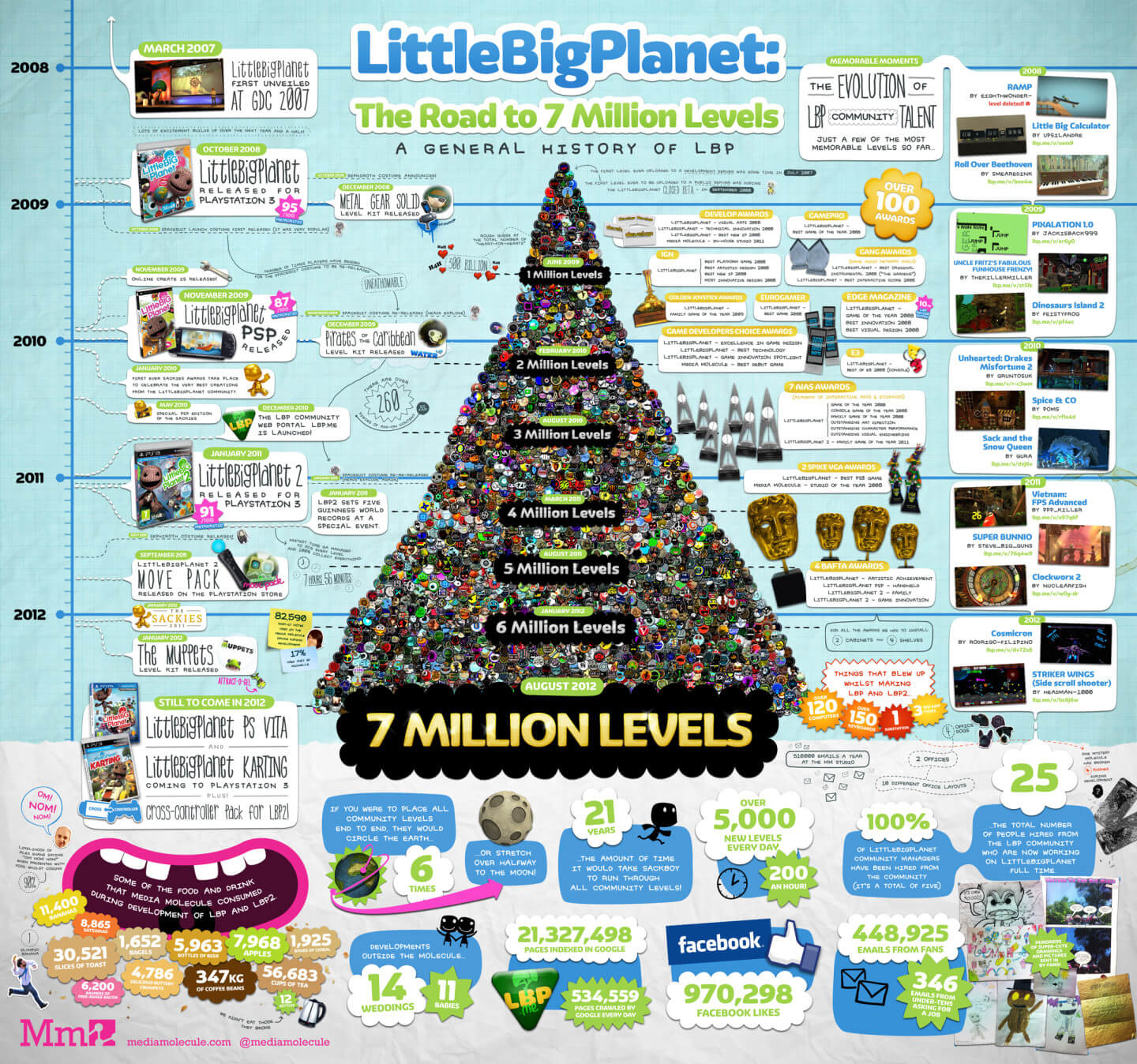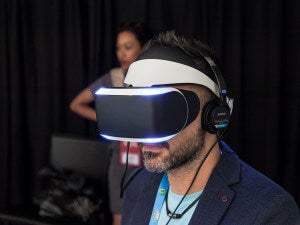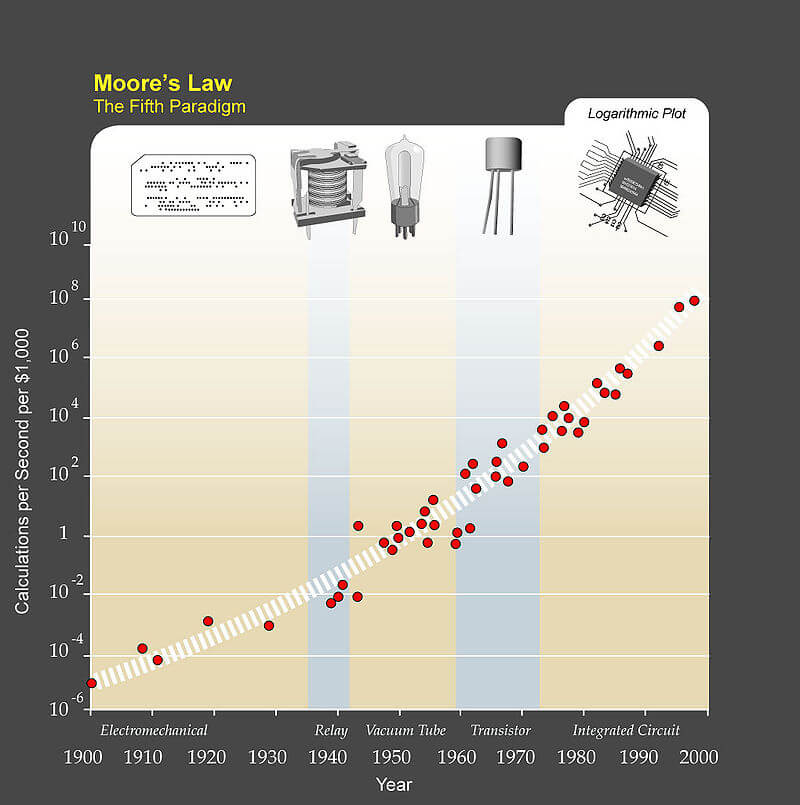The virtual reality renaissance that is now underway is creating much excitement surrounding the potential arrival of the “metaverse.” As I write, four great technology titans are competing to bring affordable head-mounted displays to market and usher VR into the mainstream [1].
While the term “metaverse” was coined by Neal Stephenson in his 1992 novel Snow Crash, current usage has diverged significantly from its original meaning. In popular contemporary culture, the metaverse is often described as the VR-based successor to the web.
Its recent surge in popularity is fueled by the expectation that the availability of affordable VR equipment will invariably lead to the creation of a network of virtual worlds that is similar to the web of today—but with virtual “places” instead of pages.
From a societal perspective, the metaverse is also associated with anticipation that as soon as VR technology reaches a sufficiently high level of quality, we will spend a significant portion of our private and professional lives in shared virtual spaces. Those spaces will be inherently more accommodating than natural reality, and this contextual malleability is expected to have a profound impact on our interpersonal relationships and overall cultural velocity.
Given its potential, it is no surprise the metaverse is a persistent topic in discussions about the future of virtual reality. In fact, it is difficult to find VR practitioners who can speculate about a plausible future where technological progress is unhindered and yet a metaverse is never created.
Still, there is little consensus on what a real-world implementation of the metaverse would be like.
Our research group, Lucidscape, was created to accelerate the advent of the metaverse by addressing the most challenging aspects of its implementation [2]. Our mandate is to provide the open source foundations for a practical, real-world metaverse that embraces freedom, lacks centralized control, and ultimately belongs to everyone.
In this article, which is part opinion and part pledge, I will share the tenets for what we perceive as an “ideal” implementation of the metaverse. My goal is not to promote our work but to provoke thought and spark a conversation with the greater VR community about what we should expect from a real-world metaverse.
Tenet #1 – Creative freedom is not negotiable
“The first condition of progress is the removal of censorship.” – George Bernard Shaw
As the prerequisite technologies become available, the emergence of a proto-metaverse becomes all but inevitable. Nevertheless, it is too soon to know what kind of metaverse will arise—whether it will belong to everybody, embracing freedom, accessibility and personal expression without compromise, or be controlled and shaped by the will and whims of its creators.
To draw a relatable comparison, imagine a different world where the web functions akin to Apple’s iOS app store. In this world, all websites must be reviewed and approved for content before they are made available to users. In this impoverished version of the web, content perceived as disagreeable by its gatekeepers is suppressed, and users find themselves culturally stranded in a manicured walled garden.
While our (reasonably) free web has become a powerful driver of contemporary culture, I would argue that a content-controlled web would remain culturally impotent in comparison because censorship inevitably stifles creativity.
Some believe that censorship under the guise of curation is acceptable under a benevolent dictator. But let me again bring forth the common example of Apple, an adored company that has succumbed to the temptation of acting as a distorted moral compass for its customers by ruling that images of the human body are immoral while murder simulators are acceptable [3].
In contrast, the ideal metaverse allows everyone to add worlds to the network since there are no gatekeepers.
In it, human creativity is unshackled by the conventions and customs of our old world. Content creators are encouraged to explore the full spectrum of possible human experiences without the fear of censorship. Each world is a sovereign space that is entirely determined and controlled by its owner-creator.
Tenet #2 – Technological freedom is not negotiable either
“If the users do not control the program, the program controls the users” – Richard Stallman
The ideal metaverse is built atop a foundation of free software and open standards. This is of vital importance not only to enforce the right to creative freedom but to safeguard a nascent network from the risks of single-source solutions, attempts of control by litigation or even abuse by its own developers.
In the long term, a technologically free metaverse is also more likely to achieve a higher level of penetration and cultural relevance.
Tenet #3 – Dismantle the wall between creators and users
“Dismantle the wall between developers and users, to develop systems so easy to program that doing so would be a natural, simple aspect of use.” – The Xerox PARC Design Philosophy [4]
Most computer users have never written a program, and most web users have never created a website.
While creative and technological freedom are required, they are not sufficient to assure an inclusive metaverse if only a small portion of the user population can contribute to the network.
It is also necessary to break the wall that separates content creators from consumers by providing not only the means but also the incentives necessary to make each and every user a co-author in the metaverse network.
This empowerment begins with the outright rejection of the current “social contract” that delineates the submissive relationship between users and the computers they use. In the current model, user contributions are neither expected nor welcome which in turn greatly diminishes the value of becoming algorithmically literate unless you intend to become a professional in the field.
However, in a metaverse where virtual components are easily inspected and modified in real-time [5], everyone could become a tinkerer first, and a maker eventually.
Thus, every aspect of the user experience in the ideal metaverse is an invitation to learn, create or remix. Worlds can be quickly composed by linking to pre-existing parts made available by other authors. The source code and other building blocks for each shared part is readily available for study or tinkering. While each world remains sovereign, visitors are nonetheless encouraged to submit contributions that can be easily accepted and incorporated [6].
 To illustrate the benefits of embracing users as co-authors, imagine that you have published a virtual model of Paris in the ideal metaverse. Over time, your simulation gains popularity and becomes a popular destination for Paris lovers around the world. To your amazement, your visitors congeal into a passionate community that submits frequent improvements to your virtual Paris, effectively becoming your co-authors. [7]
To illustrate the benefits of embracing users as co-authors, imagine that you have published a virtual model of Paris in the ideal metaverse. Over time, your simulation gains popularity and becomes a popular destination for Paris lovers around the world. To your amazement, your visitors congeal into a passionate community that submits frequent improvements to your virtual Paris, effectively becoming your co-authors. [7]
Most importantly, the basic tools of creation [8] of the ideal metaverse are accessible to children and those who are not technologically inclined. By design, these tools allow users to learn by experimentation thus blurring the lines between purposeful effort and creative play. [9]
Tenet #4 – Support for worlds of unprecedented scale
Virtual worlds of today, with a single notable exception [10], can only handle smaller-scale simulations with no more than several dozen participants in the same virtual space. To overcome this limitation, world creators sacrifice the experience of scale by partitioning worlds into a multitude of smaller instances where only a limited number of participants may interact with each other.
In contrast, the simulation infrastructure of the ideal metaverse supports worlds of unprecedented scale (e.g., whole populated cities, planets, solar systems) while handling millions of simultaneous users within the same shared virtual space.
This is an incredibly difficult challenge because it requires maintaining a coherent state across a vast number of geographically separated machines in real-time. Even as networking technology advances, there are fundamental physical limits to possible improvements in total bandwidth and latency. [11]
Fulfilling this requiremen t will require algorithmic breakthroughs and the creation of a computational fabric that allows an arbitrary number of machines to join forces to simulate large seamless worlds while at the same time gracefully compensating for unfavorable network circumstances.
t will require algorithmic breakthroughs and the creation of a computational fabric that allows an arbitrary number of machines to join forces to simulate large seamless worlds while at the same time gracefully compensating for unfavorable network circumstances.
Scalability of this magnitude is not something that can be easily bolted onto a pre-existing architecture. Instead, the creators of the ideal metaverse must take this requirement into consideration from the very beginning of development.
Tenet #5 – Support for nomadic computation
Of all tenets proposed in this essay, this is the one that is most easily contested because it is motivated not by strict necessity but by the desire to create a network that is more than the sum of its parts.
The same way that the web required a new way of thinking about information, the ideal metaverse requires a new way of thinking about computation. One of the ways this requirement manifests itself is by our proposal for the support of safe nomadic computation.
In the ideal metaverse, a nomadic program is a fully autonomous participant with the similar “rights” of a human user. Like any ordinary user, such programs can move from one server to the next on the network. To the underlying computational fabric, there is no meaningful distinction between human operators and nomadic programs other than the fact that programs carry along their source code and internal state as they migrate to a new server.
A powerful illustrative example of the potential for roaming programs is the approach taken by developer Hello Games in the development of “No Man’s Sky” [13].
By leveraging procedural content generation, a team of four artists have generated a virtual universe containing over 18 quintillion planets. Unable to visit and evaluate those worlds one by one, they resorted to the creation of a fleet of autonomous virtual robots to explore their many worlds. Each robot documents its journey and takes short videos of the most remarkable things they encounter to share with its developers.
While Hello Games’ robot explorers are not nomadic programs, the same idea could be implemented in the metaverse on a much grander scale. For example, more than merely visiting worlds in the network, nomadic programs can also interact with other users or programs, improve the worlds visited [14] or even act as the autonomous surrogate for a user who is currently offline.
Moreover, the infrastructure required for supporting nomadic computation can also be leveraged to offload work to the computers utilized by human visitors. This is beneficial because thousands of end-user machines running complex logic can create much richer experiences than what would be possible with server-side resources exclusively. [15]
The road ahead
The five tenets of the ideal metaverse shared in this article can be succinctly distilled to just two adjectives — free and distributed. Those are precisely the attributes that made the web widely successful, and the core values the metaverse must embrace to achieve a similar level of cultural relevance.
However, there are still many significant challenges ahead for the creation of a real-world metaverse.
From a hardware perspective, nothing short of a collapse of technological progress stands in the way of the required technologies being made available. Computing and networking performance continue to increase exponentially [16], and affordable head-mounted displays are just around the corner. [17]
From the software standpoint, there are a few groups already mobilizing to fulfill the promise of the metaverse. I have previously introduced our team at Lucidscape, and I feel compelled to mention our amazing friends at High Fidelity since they are also hard at work building their own vision of the metaverse. Similarly noteworthy are the efforts of Improbable.io, even though they are developing proprietary technology, their work could be useful to the metaverse in the long run [18].
Overall, recent progress has been encouraging. Last year our team at Lucidscape ran the first large-scale test of a massively parallel simulation engine where over ten million entities were simulated on a cluster composed of 6,608 processor cores [19]. Meanwhile, High Fidelity has already released the alpha version of their open source platform for shared virtual reality, and as I write this, there are 44 domains in their network, which can be earnestly described as a proto-metaverse.
Where imagination becomes reality
Nothing is as uniquely human as the capacity to dream. Our ability to imagine a better world gives us both the desire and the resolve to reshape the reality around us.
Neuroscientist Gerald Edelman eloquently defined the human brain as the place “where matter becomes imagination” [20]. It is a wondrous concept which is about to be taken a step further as metaverse establishes itself as the place “where imagination becomes reality.”
While in natural reality our capacity to imagine greatly outstrips our power to realize, virtual reality closes that gap and mainstream availability of VR will release an unfathomable amount of pent-up creative energy.
Our urge to colonize virtual worlds is easily demonstrated by success stories of video games that give users easy-to-use tools to create on their own. Media Molecule’s “Little Big Planet” receives over 5,000 submissions of user-created levels every day. Meanwhile, the number of Microsoft’s “Minecraft” worlds is estimated at the hundreds of millions.

While it is true that some of us may never find virtual reality to be as fulfilling as natural reality, ultimately we are not the ones who will realize the full potential of VR and the metaverse.
Today’s children will be the first “virtual natives.” Their malleable brains will adapt and evolve along with the virtual worlds they create and experience. Eventually they will learn to judge experiences exclusively on the amount of cognitive enrichment it offers and not based on the arbitrary labels of “real” or “virtual.”
In time, the metaverse will become humanity’s shared virtual canvas. In it, we will meet to create new worlds and new experiences that bypass the constraints of natural reality. Its arrival will set in motion a grand social experiment that will ultimately reveal the true nature of our species. [21]
How will our culture and morality evolve when reality itself becomes negotiable? Will we create worlds that elevate the human spirit to new heights? Or will we use virtual reality to satisfy our darkest desires?
To the disappointment of both the eternally optimistic and relentlessly pessimistic, the answer is likely to be a complex mixture of both.
The real world metaverse will be just as full of beauty and contain just as much darkness as the web we have today. It will be an honest mosaic portrait of experiences that is fully representative of our true cognitive identity as a species.
The problem you did not know you had
I would like to conclude by asking you to imagine a line representing your personal trajectory through life’s many possibilities. This line connects your birth to each of your most salient moments up to the current point in time, and it represents that totality of your life’s experience.
Each decision you made along the way pruned the tree of possibilities of the branches that were incompatible with the sum of your previous choices. For each door you opened, countless others were sealed shut because such is the nature of a finite human existence — causality mercilessly limits how much you can do with the time you have.
I, for example, decided to specialize in computer science so it is unlikely that I will ever become an astronaut. Since I am male and musically challenged, I will also never know what is like to be a female j-pop singer, or a person of a different race, or being born in a different century. No matter what I do, those experiences are inaccessible to me in natural reality.
The goal of this exercise is to bring to your attention that no matter how rich of a life you have lived, the breadth of your journey represents an insignificantly narrow path through the spectrum of possible human experiences.
This is how natural reality limits you. It denies you access to the full spectrum of experiences your mind requires to achieve higher levels of wisdom, empathy and cognitive well-being.
This is the problem you did not know you had — and virtual reality is precisely the solution you did not know you needed.
Notes:
[1] Namely: Oculus VR owned by Facebook, Google, Sony and HTC/Valve.
[2] Lucidscape is building a massively distributed computational fabric to power the metaverse (http://lucidscape.com)
[3] While I am not in any way opposed to violent video games, I want to make the point that by any reasonable moral scale, sex and nudity are inherently more acceptable than murder.
[4] Read more: http://dorophone.blogspot.ca/2011/07/duckspeak-vs-smalltalk.html
[5] This is conceptually similar to what was attempted by the developers of the Xerox Alto operating system because user changes are reflected immediately. See also [4]
[6] This mechanism would be conceptually similar to a “pull request”: http://oss-watch.ac.uk/resources/pullrequest
[7] “Wikiworlds” would be a good cognitive shortcut for this co-authoring model: worlds that are like Wikipedia in the aspect that anyone can contribute.
[8] Emphasis is given to the fact that the basic tools must be accessible to non-technical users. Certainly, complex tools for power users are also of critical importance.
[9] This reflects my personal wish of seeing a whole generation of kids becoming algorithmically literate by “playing” on the metaverse.
[10] Eve Online (https://eveonline.com)
[11] Read more: http://royal.pingdom.com/2007/06/01/theoretical-vs-real-world-speed-limit-of-ping
[13] Read more: http://www.polygon.com/2015/3/3/8140343/no-mans-sky-space-probes-gdc-quintillion-worlds
[14] Imagine an autonomous builder program that travels around the metaverse and uses procedural content generation to suggest improvements to the visited worlds.
[15] Another important aspect of supporting nomadic computation is to minimize the cross-talk between servers as autonomous agents roam the metaverse. Since the execution of nomadic programs is local to the server it is currently visiting, a great deal of network bandwidth can be spared.
[16] Read more: http://www.kurzweilai.net/the-law-of-accelerating-returns
[17] Coming soon: Oculus CV, Sony Morpheus, Valve HTC Vive
[18] I would like to take this opportunity to invite the great minds at Improbable to consider building a free metaverse alongside Lucidscape and High Fidelity instead of limiting themselves to the scope of the video game industry.
[19] Read more: http://www.fastcodesign.com/3036256/infographic-of-the-day/see-the-big-bang-of-the-next-internet
[20] “How Matter Becomes Imagination” is the sub-title of “A Universe of Consciousness” by Nobel Prize winner Gerald Edelman and neuroscientist Giulio Tononi.
[21] It is this author’s opinion that technology does not change us, it merely enables us to act the way we wanted to all along.
Rod Furlan is an artificial intelligence researcher, Singularity University alumnus and the co-founder Lucidscape, a virtual reality research lab currently working on a new kind of massively-distributed 3D simulation engine to power a vast network of interconnected virtual worlds. Read more here and follow him @rfurlan.
To get updates on Future of Virtual Reality posts, sign up here.
Image Credit: Shutterstock.com and mediamolecule





